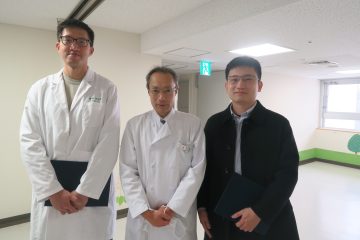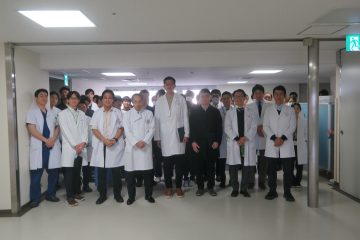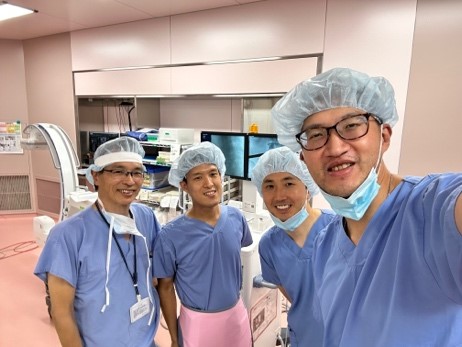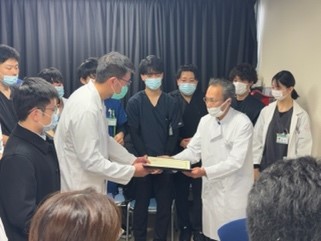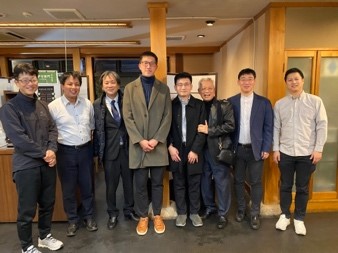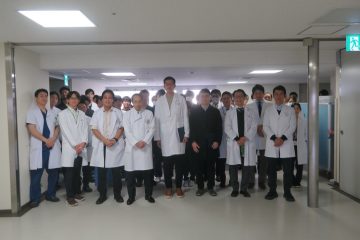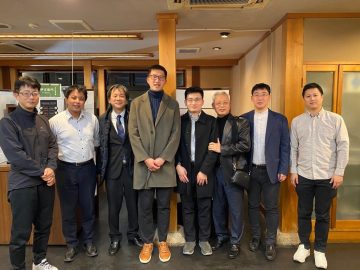台湾トラベリングフェロー受け入れのご報告
更新日 2025.1.7
H13卒 古矢丈雄
H26卒 平沢累
2024年12月2日から15日にかけて、Japan-
My Chiba Experience in December, 2024
Yung-Hsueh Hu
Spine Division, Orthopedic Surgery Department,
Chang-Gung Memorial Hospital
When I started writing this essay about my visit to Chiba, the memories resurfaced vividly as I recalled them. Photos eternalized specific moments of the past, preserving those delightful times alongside the images. The time I spent in Chiba was invaluable, fruitful, and satisfying. The extraordinary experience was a result of the combined efforts of amazing physicians and the warm hospitality of everyone I encountered. In the following paragraphs, I will describe the details of the trip as an expression of my gratitude toward everyone I met during this wonderful two-week fellowship.
Chiba University Hospital
At Chiba University Hospital, I was privileged to join the morning meeting, and I was surprised to see that all the staff remained standing throughout the entire meeting. Participating in the morning round was delightful, as the whole team worked seamlessly together to change wound dressings, see patients, and discuss special cases.
In the operating room, I observed several impressive surgeries performed by the cervical and lumbar spine teams. I was fortunate to witness Dr. Maki treat a C1 fracture case with C1-2 fixation and a thoracic spine meningioma case, which highlighted the team’s delicate surgical skills. The lumbar team showed incredible dedication and a high level of commitment to their operations.
The surgery for post-traumatic kyphosis amazed me with its meticulous operative planning, and the outcome was remarkable thanks to the excellent execution of the plan. Chief Professor Ohtori provided outstanding leadership, ensuring that the entire team remained highly dedicated to clinical practice, making my time at Chiba University Hospital both fantastic and enjoyable.
Omigawa Hospital
I spent a day at Omigawa Hospital to learn about endoscopic surgeries. Before the trip, I had researched Omigawa Hospital and discovered that Dr. Shimizu is an expert in spine endoscopy, performing more than 500 cases annually. I observed four surgeries performed by Dr. Shimizu, which included routine lumbar discectomies and laminotomies. Initially, I thought these “routine” operations might not be particularly special, but I was completely astonished by Dr. Shimizu’s phenomenal skill.
His technique for detaching the ligamentum flavum with a drill was remarkable, and his precise control of the burr tip was almost magical. Dr. Shimizu generously shared his video demonstrating the anterior endoscopic approach for treating high thoracic OPLL—a pioneering technique for this condition. I felt incredibly fortunate to witness his work and to be a part of what could represent a paradigm shift in the treatment of this specific pathology.
Seirei Sakura Hospital
As I have a personal interest in deformity correction surgery, Dr. Furuya arranged for me to visit Seirei Sakura Hospital, which is renowned for its treatment of adolescent and adult spinal deformities. The orthopedic team warmly welcomed me, and I was amazed to see Dr. Iijima perform a posterior deformity correction for an adult deformity case.
The workflow of the Seirei Sakura spine team was exceptionally smooth, and the power of the navigation system was evident during the long-segment instrumentation. The team, led by Dr. Kotani, demonstrated their artistic approach to deformity correction. The combination of sublaminar tapes and screw-based translation techniques delivered phenomenal correction power and ultimately produced beautiful results. The incorporation of the latest technology significantly enhanced the efficiency and accuracy of the operation.
After a rewarding day at the hospital, Dr. Mizutani took me to a wonderful restaurant where I enjoyed delicious Japanese cuisine. We ended the day with a delightful feast and amazing sake, making it a truly memorable experience.
Gratitude and Reflection
I am wholeheartedly grateful for this trip, and I would like to extend special thanks to Dr. Yoh for supporting and fostering the connection between Chiba University and CGMH. This relationship would not be as strong and close without Dr. Yoh’s efforts.
During this trip, I was deeply touched by the genuine hospitality of everyone I met. I felt relaxed and refreshed, taking a much-needed break from the stressful work in Taiwan. At the same time, I was recharged by witnessing the fascinating work being done by the great surgeons in Japan. What I learned during these two weeks will undoubtedly shape my skillset and improve my practice in the future.
Two-Week Observation at Chiba University Hospital
Kai-Jen Tsai
First and foremost, I would like to express my gratitude to Dr. Yoh (葉國璽先生) for his generous sponsorship and support, which made this program possible. I had the privilege of spending two weeks (December 1st to 14th, 2024) at Chiba University Hospital in Japan, where I observed and learned from their renowned orthopedic team.
During my time at the hospital, I focused on observing arthroplasties, including minimally invasive direct anterior approaches and innovative surgical equipment and devices. The precision and efficiency demonstrated by the surgeons left a deep impression on me. I also noticed that the overall pace and atmosphere of the surgeries were vastly different from those in Taiwan. However, what impressed me the most was the team's attentiveness, friendliness, and patience during ward rounds.
In addition to Chiba University Hospital, I had the opportunity to visit other esteemed medical institutions. At Oyumino Central Hospital, I observed robotic-arm assisted surgery, which was both fascinating and a completely new experience for me. I also visited the Funabashi Orthopedic Clinic, renowned for its systematic approaches and high-volume surgeries.
Beyond surgery, I also participated in outpatient clinics, where I observed the doctors’ thoughtful interactions with patients. The emphasis on clear communication, empathy, and shared decision-making was striking.
My visit to Japan was further enriched by memorable dinner invitations. The hospitality I experienced reflected the warmth and kindness of the Japanese people, making my time there even more special.
I would also like to extend my sincere gratitude to Professor Ohtori for providing this opportunity, and to Dr. Furuya and Dr. Hirasawa for their care and assistance throughout my visit. I am truly grateful for all the support they provided.
In summary, this experience was precious and inspiring. It provided me with unique insights into advanced surgical techniques, patient care, and the overall medical environment in Japan. I am deeply thankful for this opportunity and look forward to contributing to the advancement of my orthopedic care in Taiwan.



